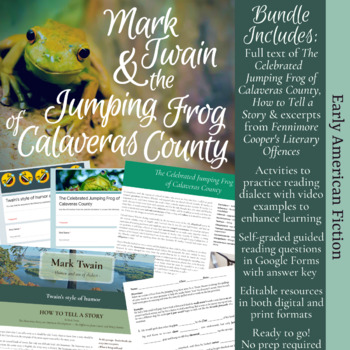Mark Twain Mini Unit: Jumping Frog of Calaveras County & Pre-Reading Activities
- Zip
- Internet Activities
What educators are saying
Products in this Bundle (4)
Description
This bundle of Mark Twain resources includes six of Twain's works, including excerpts from his autobiography, Life on the Mississippi, and Fennimore Cooper's Literary Offences, as well as the full texts of How to Tell a Story, The Turning Point in my Life, and The Celebrated Jumping Frog of Calaveras County. It's a great mini unit to introduce students to Twain, his style of humor, and use of dialect and use these skills to analyze Twain's most famous short story.
Materials in the Mark Twain mini unit include:
- A website with a short biography on Samuel Clemens/Mark Twain with excerpts from his autobiography and Life on the Mississippi
- A website explaining the historical context in which the literary movements of realism, naturalism, and regionalism emerged, the key features of each genre, an explanation of how Mark Twain helped define this era of American literature, and an excerpt from Upton Sinclair's The Jungle
- A website with the full text of Twain's essay How to Tell a Story, excerpts from Fennimore Cooper's Literary Offences related to the use of dialect, and video examples of modern examples of Twain's style of humor
- A website with the full text of Twain's short story The Celebrated (Notorious) Jumping Frog of Calaveras County in the form of an online textbook with vocabulary definitions and guiding questions
- The websites include pre-reading information such as the historical context, definitions of literary terms related to the story, and a link to a Kahoot to practice the terms using famous Mark Twain quotes
- Fully editable print versions of the websites
- Guided reading and analysis questions in both a self-grading Google Form and printable worksheets
- Answer keys
Note: The websites work as online textbooks. They can be shared with students for independent learning or projected onto a smartboard and used in place of a slide presentation. They include definitions of key terms and guiding questions and can be translated into another language, read aloud through the use of an app, or adjusted for visually impaired students at the click of a button.
Suggested order for using the materials:
Day 1 - Mark Twain Author Profile
Day 2 - The Gilded Age, Realism, Naturalism & Regionalism
Day 3 - Twain's use of humor and dialect
Day 4 - The Jumping Frog of Calaveras County
Everything is available in both print and digital formats.
The materials are ready to go but can be edited to better suit your students' needs.
Just print or post to your online classroom and you’re set!
Use for sub plans, flipped classrooms, or remote learning.
Goals for these lessons:
1. 1. For students to familiarize themselves with American history and culture in the late 1800s and better understand how these helped influence literary movements during that period.
2. For students to be able to identify similarities and differences between the movements of realism, naturalism, and realism and be able to classify writing from this time period into these categories.
3. For students to familiarize themselves with Twain's style of writing by using some of his essays ahead of reading one of his novels or short stories.
4. For students to learn elements of Twain's use of humor in order to analyze their use and how they fit into his ideal of the best way to tell a story.
5. For students to be aware of Twain's use of dialect, have tools for figuring out unknown words using context clues and other strategies and practice deciphering his use of dialect using lines from Twain's writing.
6. For students to make inferences about characters as they develop within a text.
Literary terms covered:
- Realism
- Naturalism
- Regionalism
- Satire
- Farce
- Sarcasm
- Incongruity
- Verbal Irony
- Situational Irony
- Dramatic Irony
- Dialect
- Frame story
- Foible
- Incongruity
- Hyperbole
- Tone
- Register
Other lessons as part of this unit are available in my Teachers Pay Teachers store here:
www.teacherspayteachers.com/Store/The-Little-Brown-Bird-Literature-Resources
Why use Google Sites instead of PowerPoint, Prezi, or Slides?
1. You can work through the site together as you would with a formal presentation by projecting it on your smartboard, or students can work at their own pace in a flipped classroom style. The site acts as a giant, interactive textbook.
2. It’s easier for absent students to catch up on missed work. Everything they need is presented on the site with external links to supplement learning. The lesson can also be used for sub plans.
3. Easy, immediate differentiation. Google Sites can be translated, adapted for students with low vision, or read aloud with the click of a button through Google extensions.
4. Direct links to support materials help the lesson run more smoothly.





